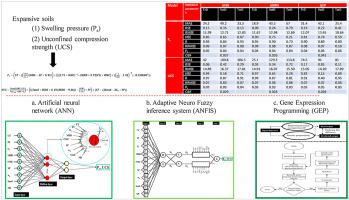Journal of Environmental Management ( IF 8.0 ) Pub Date : 2021-04-05 , DOI: 10.1016/j.jenvman.2021.112420 Fazal E. Jalal , Yongfu Xu , Mudassir Iqbal , Muhammad Faisal Javed , Babak Jamhiri

|
This study presents the development of new empirical prediction models to evaluate swell pressure and unconfined compression strength of expansive soils (PsUCS-ES) using three soft computing methods, namely artificial neural networks (ANNs), adaptive neuro fuzzy inference system (ANFIS), and gene expression programming (GEP). An extensive database comprising 168 Ps and 145 UCS records was established after a comprehensive literature search. The nine most influential and easily determined geotechnical parameters were taken as the predictor variables. The network was trained and tested, and the predictions of the proposed models were compared with the observed results. The performance of all the models was tested using mean absolute error (MAE), root squared error (RSE), root mean square error (RMSE), Nash-Sutcliffe efficiency (NSE), correlation coefficient (R), regression coefficient (R2) and relative root mean square error (RRMSE). The sensitivity analysis indicated that the increasing order of inputs importance in case of Ps followed the order: maximum dry density MDD (30.5%) > optimum moisture content OMC (28.7%) > swell percent SP (28.1%) > clay fraction CF (9.4%) > plasticity index PI (3.2%) > specific gravity Gs (0.1%), whereas, in case of UCS it followed the order: sand (44%) > PI (26.3%) > MDD (16.8%) > silt (6.8%) > CF (3%) > SP (2.9%) > Gs (0.2%) > OMC (0.03%). Parametric analysis was also performed and the resulting trends were found to be in line with findings of past literature. The comparison results reflected that GEP and ANN are efficacious and reliable techniques for estimation of PsUCS-ES. The derived mathematical GP-based equations portray the novelty of GEP model and are comparatively simple and reliable. The Roverall values for PsUCS-ES followed the order: ANN > GEP > ANFIS, with all values lying above the acceptable range of 0.80. Hence, all the proposed AI approaches exhibit superior performance, possess high generalization and prediction capability, and evaluate the relative importance of the input parameters in predicting the PsUCS-ES. The GEP model outperformed the other two models in terms of closeness of training, validation and testing data set with the ideal fit (1:1) slope. Evidently the findings of this study can help researchers, designers and practitioners to readily evaluate the swell-strength characteristics of the widespread expansive soils thus curtailing their environmental vulnerabilities which leads to faster, safer and sustainable construction from the standpoint of environment friendly waste management.
中文翻译:

使用人工智能方法:ANN,ANFIS和GEP的膨胀土膨胀强度的预测模型
这项研究提出的新的经验预测模型的开发,以评估膨胀压力和膨胀土(P的无侧限抗压强度小号使用三个软计算方法,即人工神经网络(人工神经网络),自适应神经模糊推理系统UCS-ES)(ANFIS) ,以及基因表达编程(GEP)。包含168 P s的广泛数据库经过全面的文献检索,建立了145条UCS记录。九个最具影响力和最容易确定的岩土参数被用作预测变量。对该网络进行了培训和测试,并将所提出模型的预测与观察到的结果进行了比较。使用平均绝对误差(MAE),均方根误差(RSE),均方根误差(RMSE),Nash-Sutcliffe效率(NSE),相关系数(R),回归系数(R 2)测试所有模型的性能)和相对均方根误差(RRMSE)。敏感性分析表明,在P s情况下,输入重要性的升序遵循以下顺序:最大干密度MDD(30.5%)>最佳水分OMC(28.7%)>溶胀百分比SP(28.1%)>粘土级分CF(9.4%)>塑性指数PI(3.2%)>比重G s(0.1%),而对于UCS,则遵循以下顺序:沙子(44%)> PI(26.3%)> MDD(16.8%)>淤泥(6.8%)> CF(3%)> SP(2.9% )> G s(0.2%)> OMC(0.03%)。还进行了参数分析,发现结果趋势与过去文献的发现相符。比较结果反映了GEP和ANN是P的估计有效的和可靠的技术小号UCS-ES。导出的基于GP的数学方程式描述了GEP模型的新颖性,并且相对简单可靠。小号UCS-ES依次为:ANN> GEP> ANFIS,与躺在上面的0.80的可接受范围的所有值。因此,所有提出的AI方法都表现出优异的性能,具有较高的泛化和预测能力,并评估了输入参数在预测P s中的相对重要性。UCS-ES。GEP模型在具有理想拟合(1:1)斜率的训练,验证和测试数据集的紧密度方面优于其他两个模型。显然,这项研究的结果可以帮助研究人员,设计人员和从业人员轻松评估广泛膨胀土壤的膨胀强度特性,从而减少其环境脆弱性,从环境友好型废物管理的角度出发,从而可以更快,更安全和可持续地进行施工。











































 京公网安备 11010802027423号
京公网安备 11010802027423号